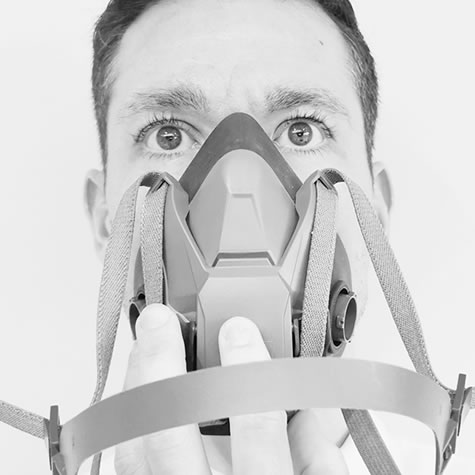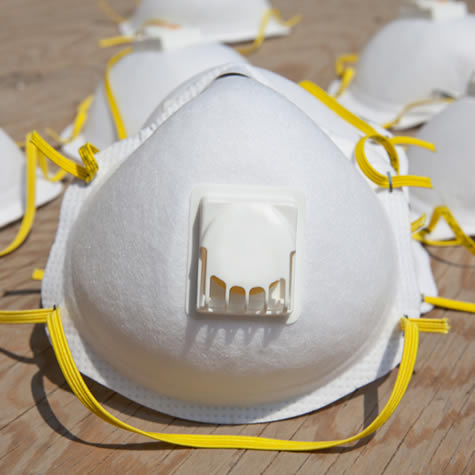Qualitative Face-Fit Testing In Neath
On Site Face Fit Testing In Neath
If your company is based in Neath and you require qualitative face-fit testing for your employees, we at Fire Coral Ltd can provide you with testing by a Fit2Fit accredited provider.
As part of your company health and safety remit, if you provide your staff with respiratory equipment (RPE) you require certification that they fit your staff correctly, are used in the correct manner, and maintained in line with legal requirements. The Health & Safety Executives (HSE) guidance note INDG 479 lays bare the need for face fit testing.
Face-fit testing is required, especially if your employees work in a dusty environment within Neath. The COSHH (Control of Substances Hazardous to Health) Regulations state then when selecting RPE equipment, a face-fit test is a way of ensuring an adequate seal is achieved. Did you know over 50% of masks tested on those with no training failed a face fit test.
By following the guidance laid out in INDG 479 & HSG 53 with regards RPE, you are meeting the regulatory requirements expected of you.
Book Your Face Fit Testing Today
Give us a call to discuss face-fit testing your employees in Neath
Qualitative Face Fit Testing Firm That Covers Neath
All close fitting masks should be face fit tested on the wearer to demonstrate whether they work or not. The types of masks which would need face-fit testing include, disposable face masks (FFP3), half masks & full-face masks. Here at Fire Coral Ltd, we provide qualitative testing for workers in Neath using half-face disposable or reusable masks only.
Neath Face Fit Testing
A face fit test is a set of exercises simulating everyday movement to determine whether an adequate seal is maintained. There are 7 exercises which each staff member should complete, each lasting for 1 minute. If one of the exercises is failed, the whole test needs to be re-taken. We will test your staff in groups of nine in slots 1.5 hours apart to minimise downtime to yourselves.
On Site Face Fit Testing Companies That Cover Neath
Normal working conditions should be simulated during the test, as mentioned in INDG 479. It is recommended that staff should be using dynamic movements such as walking, stepping and cycling on exercise machines.
If your staff in Neath use RPE on a regular basis, and you would like to ensure they are fully trained in the wearing, fitting, and use of their respiratory equipment; Fire Coral Ltd can provide you with a tailored training package at a preferential rate.
About Neath
Historically, Neath was the crossing place of the River Neath and has existed as a settlement since the Romans established the fort of Nido or Nidum in the AD 70s. The Roman fort took its name from the River Nedd; the meaning is obscure but ‘shining’ or simply ‘river’ have been suggested. Neath is the Anglicised form. The Antonine Itinerary (c.?2nd century) names only nine places in Roman Wales, one of them being Neath. There is evidence of undated prehistoric settlements, probably Celtic, on the hills surrounding the town. The fort covered a large area which now lies under the playing fields of D?r-y-Felin Comprehensive School. In the late 1960s, there were reports in the local media of a massive Roman marching camp being found above Llantwit which would have accommodated many thousands of troops.St Illtyd visited the Neath area and established a settlement in what is now known as Llantwit on the northern edge of the town. The church of St Illtyd was built at this settlement and was enlarged in Norman times. The Norman and pre-Norman church structure remains intact and active to day within the Church in Wales. The Welsh language name for Neath is Castell-nedd, referring to the Norman Neath Castle, which was visited by English kings Henry Curtmantle, John Lackland and Edward Longshanks.Neath CastleNeath was a market town that expanded with the arrival of the Industrial Revolution in the 18th century with new manufacturing industries of iron, steel and tinplate. The Mackworth family, who owned the Gnoll Estate were prominent in the town’s industrial development. Coal was mined extensively in the surrounding valleys and the construction of canals and railways made Neath a major transportation centre and the Evans & Bevan families were major players in the local coal mining community as well as owning the Vale of Neath Brewery. Silica was mined in the Craig-y-Dinas area of Pontneddfechan, after Quaker entrepreneur William Weston Young invented the blast furnace silica firebrick, later moving brick production from the works at Pontwalby to the Green in Neath. The town continued as a market trading centre with a municipal cattle market run by W.B.Trick. Industrial development continued throughout the 20th century with the construction by BP of a new petroleum refinery at Llandarcy.Admiral Lord Nelson stayed at the Castle Hotel en route to Milford Haven when the fleet was at anchor there[citation needed]. Lt. Lewis Roatley, the son of the landlord of the Castle Hotel, served as a Royal Marines officer with Nelson aboard HMS Victory in the Battle of Trafalgar.The River Neath is a navigable estuary and Neath was a river port until recent times. The heavy industries are no more with the town being a commercial and tourism centre. Attractions for visitors are the ruins of the Cistercian Neath Abbey, the Gnoll Park and Neath Indoor Market.Neath hosted the National Eisteddfod of Wales in 1918, 1934 and 1994. The art work was unveiled intact at its new setting in the centre of Port Talbot after being lifted by crane onto a lorry and moved slowly and carefully to Tyr Orsaf, an award winning homes and shops development opposite the towns transport hub and railway station.Seasons Greetings suddenly appeared on steelworker Ian Lewiss garage in Taibach last December and news of its dramatic arrival quickly spread across the world. In January this year, Essex gallery owner and street art expert John Brandler purchased the famous mural for a six figure sum.Subsequently, Neath Port Talbot Council entered into a partnership with Mr Brandler, housing group Pobl and the Welsh Government to place Seasons Greetings in a commercial unit in Tyr Orsaf.Experienced Port Talbot based building and civil engineering firm Andrew Scott Ltd undertook the tricky job of transporting the iconic Banksy, cutting the art work from the rest of the garage with a diamond drill.Afterwards, a sturdy steel framework was put in place to act as a cradle when the artwork was lifted by into the air the strain being put on the steel frame, not the artwork. The Banksy was successfully loaded onto a lorry and taken with a police escort to Tyr Orsaf photographed all the way by members of the public, press and media – where it was successfully installed.The section of wall on which Seasons Greetings was painted weighs around 4.5 tonnes.The Leader of Neath Port Talbot Council, Cllr Rob Jones said afterwards: We are pleased to be working in partnership with the Welsh Government, Pobl and Mr Brandler on this and our thanks go to Andrew Scott Ltd for an excellent job in moving this piece of art.




